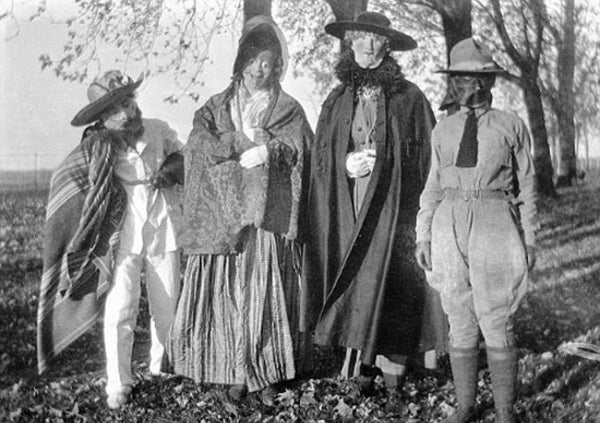Halloween is almost upon us all, heralding the descent of unwashed hordes of pirates, fairies, princesses and ghosts upon our doors. As you stand guard over your gate, bribing these little ne’er-do-wells into leaving your castle untouched, you may wonder how this tradition came to pass. Of course, we’re talking about the modern version of trick-or-treating.
The Beginnings

The history of Halloween is well known, with the Catholic Church gobbling up pagan holidays and putting their own twist on them. Thus was it with the Celtic holiday of Samhain, celebrated at the end of harvest and marking the beginning of the dark days of winter. In around 800 C.E., the Catholics took the Celtic belief that the veil between the living and the dead were weakest at this point and turned it into All Saint’s Day and All Hallow’s Eve. But how did this turn into dressing up as Cinderella or a cowboy and getting candy?
Because the Celts believed that the dead could come through into the land of the living, they also believed that dark entities, such as devils and demons, could walk among us as well. So dressing up in costume helped disguise the common folk should they meet a demon. The Catholics kept this practice alive and in the Middle Ages, it had evolved to poor adults and children dressing up and offering songs and prayers for the dead in exchange for favors. This was called “souling” and the people dressing up were known as “soulers.”
Changing With the Times

The practice changed with the times, and beginning in the mid-19th century, children in Great Britain and the UK were participating in “guising.” The kids would beg at doors for small favors such as fruit or money and offer jokes, songs or other small performances. This tradition immigrated to North America in the early 20th century, eventually morphing into trick or treating. The first reference to “trick or treat” is in the November 4, 1927 edition of the Blackie, Alberta Canada Herald, where the paper printed the following excerpt:
“Hallowe’en provided an opportunity for real strenuous fun. No real damage was done except to the temper of some who had to hunt for wagon wheels, gates, wagons, barrels, etc., much of which decorated the front street. The youthful tormentors were at back door and front demanding edible plunder by the word “trick or treat” to which the inmates gladly responded and sent the robbers away rejoicing.”
The practice was embraced by communities all over the United States who saw it as a way to combat the destructive pranks that were happening that night. In some cities, the pranks caused almost $100,000 in damages. Trick or treating was quickly put to the wayside when World War II broke out because of sugar rationing.
In the 1950’s with the war over, candy companies saw an opportunity to boost sales in a lean period between summer and the winter holidays. They organized a marketing campaign that was focused on the tradition of trick or treating, emphasizing the good natured and wholesome fun that could be shared among families. This quickly became the tradition we know and celebrate today.

Here are some other things you probably didn’t know about Halloween:
- The word Halloween originally came from the Middle English word, Alholowmesse which meant “All Saints’ Day”. The night before Alholowmesse was “All Hallows Even” which was shortened to “Hallowe’en” and then “Halloween” in the 20th century.
- Halloween is actually the beginning of a three-day Catholic festival that runs from October 31 to November 2. The three days are known as All Saint’s Eve, All Saint’s Day, and All Souls’ Day.
- About 600 million pounds of candy is purchased in the United States for Halloween with about 90 million pounds of chocolate sold in the week leading up to the holiday.
- Shakespeare mentions the tradition of Halloween in the play, Two Gentlemen of Verona, where he wrote in Act 2, Scene 1, “...like a young wench that had buried her grandam; to fast, like one that takes diet; to watch like one that fears robbing; to speak puling, like a beggar at Hallowmas.”
- An estimated $3 billion is spent on Halloween costumes annually in North America.
- Haunted houses are also very popular, netting about $500 million in revenue every year
- The most popular candy bars to receive on Halloween are Reese’s peanut butter cups followed by M&M’s and then Snickers bars.
So there you are. Next time someone asks you if you know how the tradition of trick or treating started, you can quote us and our article. And as a final tip, when you’re handing out candy, don’t forget the beleaguered parents standing anxiously on the sidewalk watching their young ones waddling up to your front door. A hot cup of coffee or even a bottle of water is never a bad thing to offer to them, especially in a year when we seem to be divided by artificial political lines. We at Think Crucial would like to take this opportunity to wish you and yours a very happy and a safe Halloween.


